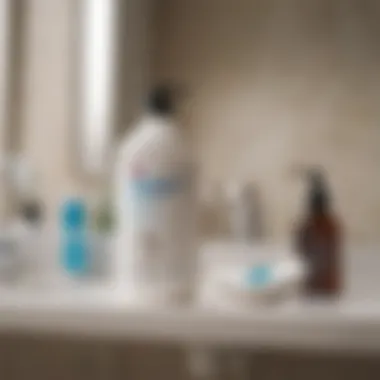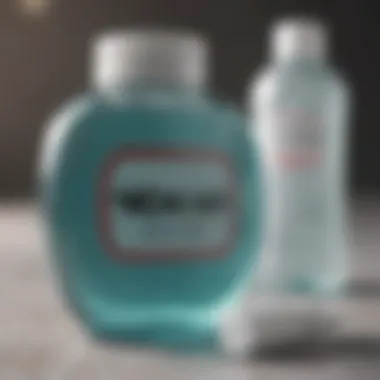Hydrogen Peroxide as a Mouthwash: Efficacy and Safety


Intro
Hydrogen peroxide is a common household chemical often found in first aid kits. It is widely known for its antiseptic properties. However, its application extends beyond simple wound care. Many question whether this compound can be effectively used as a mouthwash. This article aims to explore the viability of hydrogen peroxide as a mouthwash, assessing its efficacy, safety concerns, and implications for dental health. Understanding the potential benefits and drawbacks of hydrogen peroxide in oral hygiene can guide individuals in making informed decisions about their mouth care routines.
Assessing Efficacy
The primary appeal of hydrogen peroxide lies in its antiseptic nature. Diluted solutions, typically around 1-3%, can be used as a mouth rinse. This dilution is significant since higher concentrations can be harmful. Research indicates that hydrogen peroxide can help in reducing oral bacteria, which contributes to bad breath and gum disease. A study published in the Journal of Clinical Dentistry showed that using hydrogen peroxide as a mouthwash could lower bacterial counts significantly, outperforming some traditional mouthwashes.
Application Methods
When using hydrogen peroxide, proper dilution is crucial. Here are the steps for safe application:
- Dilute: Mix one part of 3% hydrogen peroxide with two parts of water. This results in a safe concentration for oral use.
- Rinse: Take a small amount, around 15-20 ml, in your mouth. Swish it around for about 30 seconds to 1 minute.
- Spit Out: Do not swallow the solution. Spit it out and rinse your mouth with plain water afterward to remove any residue.
Safety Considerations
While hydrogen peroxide shows promise, safety should not be overlooked. Users must be cautious to avoid potential side effects. Some concerns include:
- Mucosal Irritation: Prolonged exposure or high concentrations can irritate oral soft tissues.
- Sensitivity Reactions: Some individuals may experience sensitivity or an allergic response.
- Staining: Regular use may lead to staining of teeth over time.
Recommendations for Use
For those considering hydrogen peroxide in their oral hygiene regimen, moderation is key. It is advisable to limit use to a few times per week and supplement it with traditional brushing and flossing. Regular consultation with dental professionals can help determine the best practices tailored to individual needs.
"Using hydrogen peroxide can support oral hygiene, but it must be done cautiously to avoid adverse effects."
Finale
The exploration of hydrogen peroxide as a mouthwash reveals both its potential benefits and risks. While it can serve as an effective antimicrobial agent, users must be mindful of its application methods and frequency. Through proper usage, hydrogen peroxide can fit into a broader oral care strategy. This holistic approach emphasizes informed choices, underscoring the importance of balancing innovative methods with traditional practices in oral hygiene.
Preface to Hydrogen Peroxide
Hydrogen peroxide is a compound that has gained attention not only for its household uses but also for its potential in oral care. Understanding this substance is crucial to evaluating its efficacy and safety as a mouthwash. The relevance of hydrogen peroxide stems from its chemical properties that allow it to act as an antimicrobial agent. In the context of dental hygiene, its applications may offer a form of alternative oral care that some individuals find appealing.
Furthermore, it is important to examine how hydrogen peroxide works and whether such use aligns with health recommendations. This article will shed light on various attributes of hydrogen peroxide, assessing both its benefits and considerations in the realm of oral hygiene.
Chemical Composition and Properties
Hydrogen peroxide, represented chemically as H₂O₂, consists of two hydrogen atoms and two oxygen atoms. This simple structure contributes to its functions in disinfection and whitening. Its peculiar properties allow it to release oxygen when it decomposes, leading to a bubbling effect that can aid in cleaning wounds and potentially, the mouth.
The stability of hydrogen peroxide varies with concentration levels. Commonly available solutions can range from 3% to 35% concentrations for different purposes. Notably, the lower concentrations are typically utilized in dental care while higher concentrations may pose risks.
One significant aspect of hydrogen peroxide's functionality lies in its oxidative capabilities. This means that it can disrupt the cellular structure of bacteria, rendering them ineffective. Understanding this mechanism is critical for its potential use in combating oral pathogens and supporting overall dental health.
"Using hydrogen peroxide in oral care should be approached with caution, particularly regarding the concentration used."
In summary, hydrogen peroxide possesses beneficial properties, but it must be used with an awareness of its concentration and application. As the article explores its historical use, mechanisms of action, and safety, these foundational insights into its chemical nature will guide the understanding of its role in oral care.
Historical Use of Peroxide in Oral Care
The historical application of hydrogen peroxide in oral care is integral to understanding its current relevance and potential benefits. Often regarded as a simple disinfectant, hydrogen peroxide has played a role in oral hygiene for many decades. Its effectiveness against bacteria, fungi, and viruses makes it a compelling choice for those looking for alternative hygiene solutions. This narrative highlights two critical areas: its origins as a natural disinfectant and its evolution in dental practices.
Origins as a Natural Disinfectant


Hydrogen peroxide is a compound with strong oxidizing properties. It was discovered in the early 19th century and quickly gained recognition for its antiseptic qualities. Its bubbling reaction when applied to wounds allowed for removal of debris and dead tissue, earning it a reputation as one of the earliest natural disinfectants. In oral health, it could be utilized as a rinse to sanitize the mouth and promote healing of minor cuts or irritations in the gums.
The appeal of hydrogen peroxide as a mouthwash can be attributed to its dual functioning: it serves as an effective cleaner and provides a mild whitening effect on teeth. Many people turned to hydrogen peroxide for these reasons before the widespread availability of commercial mouthwash products with specific formulations.
Hydrogen peroxide served as a natural solution for oral hygiene long before modern dentistry established guidelines for care.
Evolution of Use in Dental Practices
Over time, the use of hydrogen peroxide transitioned from home remedy to an accepted practice within dental hygiene. By the mid-20th century, dental professionals began to endorse its use as part of regular oral care routines. Dentists noted its effectiveness in treating gingivitis and other gum-related diseases. It is not uncommon to find hydrogen peroxide within the formulations of commercial dental products, capitalizing on its disinfectant properties.
This evolution reflects a broader trend in oral health toward seeking out more effective and minimalistic treatments. Its inclusion in clinical practices highlights a collective move towards scientifically-supported methods of maintaining oral hygiene. Dental experts have often recommended diluted solutions to minimize potential irritations while harnessing its beneficial effects.
Mechanisms of Action
Understanding the mechanisms of action of hydrogen peroxide provides crucial insights into its potential effectiveness as a mouthwash. This section highlights two main aspects: the antimicrobial properties and the whitening effects on teeth. Each of these factors contributes to the overall viability of hydrogen peroxide as a dental hygiene solution, impacting both oral health and aesthetic concerns.
Antimicrobial Properties
Hydrogen peroxide’s antimicrobial properties play an essential role in its function as a mouthwash. It is a well-known disinfectant effective against a broad spectrum of microorganisms. When hydrogen peroxide comes into contact with bacteria, it breaks down into water and oxygen, releasing free radicals. These free radicals are reactive molecules that can damage essential cellular components of bacteria, ultimately leading to their death. This action significantly reduces the bacterial load in the mouth, which is vital for preventing dental issues such as cavities and gum disease.
Moreover, the oxidative action of hydrogen peroxide can contribute to the reduction of dental plaque. Plaque is a sticky film of bacteria that forms on teeth and can lead to tartar buildup if not properly managed. By using a diluted solution of hydrogen peroxide as a mouthwash, individuals may improve their oral hygiene routines and combat these common dental concerns.
"Hydrogen peroxide acts effectively against bacteria by breaking down their cellular structure, thus decreasing the risk of infections."
Whitening Effects on Teeth
In addition to its antimicrobial effects, hydrogen peroxide is also recognized for its ability to whiten teeth. This property is particularly appealing to those seeking a brighter smile without the need for expensive and potentially harmful whitening treatments. When hydrogen peroxide is applied to the surface of teeth, it penetrates the enamel and dentin layers, releasing oxygen molecules that break down complex stains.
The whitening process is not instantaneous; it may require consistent use over time. However, many users report effective results when incorporating hydrogen peroxide as a mouthwash into their oral care routines. It is important to note that the efficacy of hydrogen peroxide in whitening can vary based on several factors, including its concentration and the individual's specific dental conditions.
Utilizing hydrogen peroxide for its whitening effects can offer a dual benefit—oral hygiene improvement and aesthetic enhancement. This makes it a popular option for individuals looking to maintain both their oral health and appearance.
Safety and Efficacy
When considering the use of hydrogen peroxide as a mouthwash, safety and efficacy emerge as critical aspects. A comprehensive understanding of both can lead to informed choices about oral health practices. Hydrogen peroxide, in varying concentrations, exhibits properties that may be beneficial in oral care. However, knowing the balance between effectiveness and safety is paramount.
Proper Concentration Levels
Using hydrogen peroxide for oral hygiene necessitates careful attention to its concentration levels. Generally, a solution of 3% hydrogen peroxide is considered safe for use as a mouthwash. Higher concentrations can cause irritation or damage to oral tissues. The efficacy as an antimicrobial agent peaks at this concentration, making it effective for reducing oral bacteria without compromising safety.
Individuals may dilute the solution further, often mixing it with equal parts of water. This reduces the risk of irritation while still delivering antimicrobial benefits. It is essential to follow guidelines or consult with a healthcare professional to ensure the proper usage and concentration are maintained.
Studies Supporting Use as Mouthwash
A number of studies have been conducted to assess the efficacy of hydrogen peroxide as a mouthwash. Research indicates that it can effectively reduce levels of oral bacteria and plaque, contributing to better oral hygiene. For example, a 2014 study published in The Journal of Clinical Dentistry demonstrated that a hydrogen peroxide mouthwash significantly improved periodontal health markers when compared to a control group.
Additionally, the properties of hydrogen peroxide allow for it to act as a mild bleaching agent. This dual action enhances its appeal for those seeking not only cleanliness but also esthetic improvement. However, it is important to note that while studies support its use, individual experiences may vary.
"Hydrogen peroxide, due to its antibacterial properties, has shown promise in clinical studies for maintaining oral health. However, understanding personal tolerance is crucial."
Potential Side Effects
Despite its benefits, using hydrogen peroxide as a mouthwash is not without potential side effects. Some users may experience irritation of the gums or soft tissues in the mouth. This is often more pronounced in individuals who use higher concentrations or do not dilute the solution adequately.


Other side effects can include:
- Changes in taste: Some users report a temporary alteration in taste sensation.
- Mucosal burns: Contact with excessive amounts might lead to burns in sensitive individuals.
- Prolonged use risks: Regular use over a long period can also disrupt the oral microbiome, potentially leading to other oral issues.
It is advisable for individuals to monitor their response and consult a dental professional if any adverse reactions occur. As with any oral care product, moderation is key to achieving the desired benefits without undermining safety.
Comparative Analysis with Conventional Mouthwashes
Comparing hydrogen peroxide to traditional mouthwashes provides important insights into oral care. Understanding this comparison can highlight the strengths and weaknesses inherent in each option. Many consumers are curious about how the efficacy of hydrogen peroxide measures against established products available in dental care. In this context, it is crucial to consider several specific elements, including active ingredients, benefits, and potential drawbacks.
Active Ingredients in Commercial Mouthwashes
Commercial mouthwashes often contain a variety of active ingredients designed for specific purposes. Commonly used components include:
- Chlorhexidine: A powerful antiseptic, chlorhexidine is effective against bacteria. However, long-term use can lead to tooth staining.
- Cetylpyridinium Chloride: This is also an antimicrobial agent, which enhances oral hygiene. Some users may experience altered taste sensations.
- Essential Oils: Many brands use essential oils for their antibacterial properties, often providing a natural option without the disadvantages of synthetic chemicals.
- Fluoride: Present in some formulations to help prevent cavities, fluoride is important for remineralizing tooth enamel but may contribute to hyperfluorosis when overused.
Effectiveness of Hydrogen Peroxide versus Other Ingredients
Hydrogen peroxide serves as an alternative due to its dual role as a disinfectant and whitener. It has several advantages when compared to other active ingredients:
- Antimicrobial Efficacy: Studies show hydrogen peroxide kills a range of bacteria, making it effective at reducing plaque and gingivitis.
- Whitening Properties: Unlike many commercial mouthwashes, hydrogen peroxide can help brighten teeth when used correctly, leading to a visible improvement in appearance.
- Natural Alternative: For those seeking less chemical exposure, hydrogen peroxide presents fewer synthetics than many commercial options.
That said, there are considerations. The concentration of hydrogen peroxide matters. While low concentrations (around 1-3%) are generally safe, higher levels can lead to irritation.
"Research indicates that hydrogen peroxide can effectively reduce oral pathogens, comparable to traditional mouthwashes. However, concentration and proper use are key factors to ensure safety."
Practical Considerations for Use
When discussing the use of hydrogen peroxide as a mouthwash, several practical considerations must come into play. These factors ensure that users apply hydrogen peroxide safely and effectively, maximizing its benefits while minimizing any risks associated with its use. Understanding these considerations is crucial for anyone interested in enhancing their oral hygiene routine.
Dilution Ratio Recommendations
Hydrogen peroxide is a potent compound, and its effectiveness is directly related to its concentration. Typically, a 3% solution is recommended for use as a mouthwash. This concentration is sufficient to achieve antimicrobial effects without risking significant irritation to the mucous membranes in the mouth.
To use hydrogen peroxide safely as a mouthwash, it should be diluted further. A common dilution involves mixing one part of 3% hydrogen peroxide with two parts of water. This results in a lower concentration that is gentler on the oral tissues. It is essential not to exceed this dilution ratio, as higher concentrations can cause harm.
A well-diluted solution of hydrogen peroxide can aid in oral hygiene without causing undue irritation.
Frequency of Use
The frequency of using hydrogen peroxide as a mouthwash plays a critical role in its efficacy and safety. Generally, it is advisable to use the diluted solution no more than two to three times a week. This prevents overexposure and potential irritation of the oral tissues. Overuse can lead to dryness, sensitivity, or other adverse reactions that may compromise oral health rather than enhance it.
For those looking to incorporate hydrogen peroxide into their oral care regimen, it can be beneficial to monitor how your mouth responds after usage. Adjust your frequency based on the observed comfort and effectiveness. Consulting a healthcare professional before starting such a regimen is always a recommended practice.
Signs of Adverse Reactions
While hydrogen peroxide can be effective, it's crucial to be aware of potential adverse reactions. Users should monitor for the following signs:
- Irritation or burning sensation: Feelings of discomfort or burning may indicate that the solution is too concentrated or that it is being used too frequently.
- Dryness in the mouth: This can be a sign of overuse and may warrant a reduction in frequency or dilution.
- Allergic reactions: Although rare, some individuals may have an allergic reaction to hydrogen peroxide, resulting in swelling or severe discomfort.
If any of these symptoms occur, it is wise to discontinue use and consult with a healthcare provider. Assessing the body's response ensures that the practice of using hydrogen peroxide as a mouthwash remains safe and beneficial.
Alternatives to Hydrogen Peroxide Mouthwash


Hydrogen peroxide has gained attention as a potential mouthwash, yet many individuals seek alternatives for various reasons, ranging from taste preferences to concerns over safety. It is crucial to evaluate an array of options available in the realm of oral hygiene which can provide similar benefits but may align better with personal values or health considerations. Understanding these alternatives can empower consumers to make informed choices regarding their oral care practices.
Natural Remedies for Oral Hygiene
Natural remedies for oral hygiene have been utilized throughout history, offering gentler and often safer options for maintaining oral health. These remedies encompass a variety of substances, each with specific antimicrobial or antibacterial properties. Some notable choices include:
- Coconut Oil: Known for its antibacterial properties, coconut oil is often used in oil pulling to help reduce plaque and promote oral hygiene.
- Salt Water: A saline solution serves as a natural disinfectant, assisting in the reduction of inflammation and aiding healing in the mouth.
- Baking Soda: This mild abrasive can help in whitening teeth and neutralizing acid in the mouth, contributing to overall oral health.
- Tea Tree Oil: This essential oil possesses antimicrobial qualities and is sometimes added to homemade mouthwashes to combat bad breath.
Utilizing these natural remedies can be appealing for those prioritizing holistic health approaches. It is essential, however, to conduct thorough research and, ideally, consult with a healthcare provider to determine the most effective and safe option for individual needs.
Commercial Mouthwash Options
For those who prefer convenience, commercial mouthwash products serve as readily available alternatives to hydrogen peroxide. The market offers a wide array of mouthwash formulations containing various active ingredients targeting different oral health concerns. Some common options include:
- Chlorhexidine: Often prescribed for patients with gum disease, chlorhexidine mouthwash is effective in reducing plaque and managing gingivitis.
- Cetylpyridinium Chloride: Commercially available mouthwashes with this ingredient provide antibacterial properties and help reduce bad breath.
- Fluoride Mouthwashes: These mouthwashes are particularly beneficial for those at risk of cavities, as fluoride strengthens tooth enamel and combats decay.
- Alcohol-Free Mouthwashes: For those sensitive to alcohol, there are various non-alcoholic options available that still offer effective antimicrobial benefits without the associated burning sensation.
Each of these commercial options can come with distinct benefits, but users should pay close attention to ingredient lists and select products that suit individual oral health needs. Consulting a dentist can provide personalized recommendations based on one's dental history.
Consumer Perspectives and Recommendations
In the discourse surrounding dental care, consumer perspectives and recommendations play a crucial role. Being informed empowers individuals to make choices that align with their health values and needs. As people increasingly seek alternatives to traditional oral hygiene products, understanding various viewpoints offers insights into the efficacy and safety of hydrogen peroxide as a mouthwash.
User Testimonials and Experiences
Many individuals have shared their experiences with hydrogen peroxide mouthwash, often reflecting a mixed bag of outcomes. Some users have noted noticeable improvements in oral hygiene, reporting fresher breath and fewer instances of gum inflammation after using diluted hydrogen peroxide.
- Positive Experiences: Some consumers rave about the whitening effects and the reduction in dental plaque. They appreciate the low-cost and accessibility of hydrogen peroxide, often finding it effective for maintenance between routine dental visits.
- Negative Experiences: On the other hand, some users have reported sensitivity issues, such as gum irritation or increased tooth sensitivity. These adverse effects often arise from improper dilution or excessive use.
"I started using hydrogen peroxide a couple of years ago as a mouthwash. At first, I loved it for its whitening properties. However, after a few weeks, I noticed my gums became irritated. I had to adjust my usage to every few days instead of daily."
- User testimonial from a dental forum.
Such testimonials indicate the need for careful consideration and perhaps consultation with dental professionals before integrating hydrogen peroxide into one’s oral care routine.
Expert Opinions on Using Hydrogen Peroxide
Expert opinions vary, but many emphasize the importance of proper use. Dentists often recognize hydrogen peroxide as a useful adjunct to oral hygiene but caution against its misuse.
- Safety First: Most dental professionals recommend using a dilution of 3% hydrogen peroxide. Concentrated forms can cause significant harm, including burns or irritation.
- Effectiveness: Experts highlight its efficacy in killing harmful bacteria and contributing to a whiter smile.
- Not a Replacement: Many agree that hydrogen peroxide should not completely replace conventional mouthwashes or regular brushing and flossing. Sound dental hygiene habits are essential for maintaining overall oral health.
In summary, while user testimonials reveal a range of experiences, expert advice underscores the necessity for caution and informed use. A thoughtful approach to incorporating hydrogen peroxide into one’s oral care may lead to a more favorable outcome.
Ending and Final Insights
The exploration of hydrogen peroxide as a potential mouthwash reveals significant insights into its effects on oral health. Hydrogen peroxide stands out due to its unique chemical properties and historical applications in dental care. Proper use can yield various benefits, such as enhanced oral hygiene and teeth whitening. It is crucial to discuss the implications that arise from its use. Understanding the mechanisms by which this chemical operates within the mouth can clarify its role as an effective antiseptic.
In this article, we have seen that hydrogen peroxide can kill bacteria and help maintain an appropriate balance of oral flora. However, its use is not without attention to safety considerations. It’s essential to adhere to recommended concentration levels to avoid potential side effects, making the information within this article valuable for anyone contemplating its use as a mouthwash.
Summary of Findings
The analysis yielded several key points:
- Efficacy: Hydrogen peroxide is effective in reducing microbial load in the mouth, aiding in oral hygiene and preventing conditions like gingivitis.
- Safety: Users must ensure they follow appropriate dilution guidelines. Concentrations above 3% can be harmful.
- Experiential Evidence: User reviews indicate a mix of positive outcomes and concerns regarding sensitivity and taste.
- Alternatives: There are many commercial mouthwash options available, but hydrogen peroxide offers a cost-effective solution for several users.
Final Recommendations for Oral Care
To integrate hydrogen peroxide safely into oral care, consider the following recommendations:
- Dilution: Always dilute hydrogen peroxide to a safe concentration, ideally around 3%.
- Frequency of Use: Limit use to a few times a week to prevent irritation.
- Monitor Reactions: Pay attention to any adverse reactions. If sensitivity occurs, discontinue use and consult a dental professional.
- Complementary Practices: Do not rely solely on hydrogen peroxide. Combine it with regular brushing and flossing for optimal oral health.
- Consultation: Seek advice from a healthcare provider before starting any new treatment for oral hygiene, especially if you have existing dental issues.
Understanding the balance between effectiveness and safety is key to utilizing hydrogen peroxide in oral care effectively.







